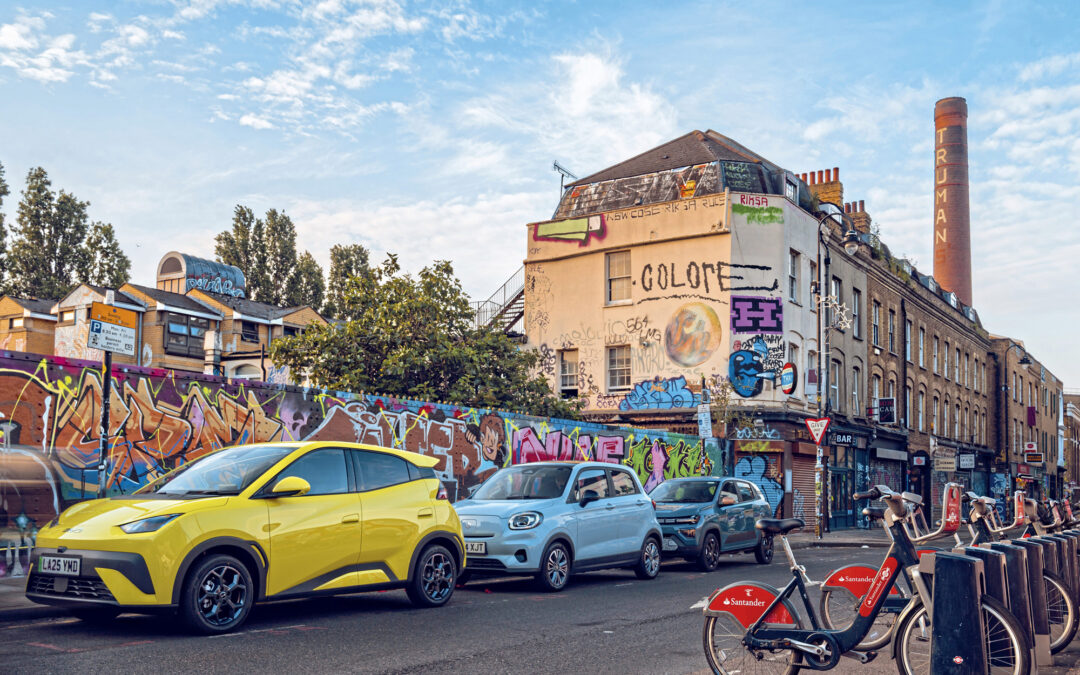DACIA SPRING | LEAPMOTOR T03 | BYD DOLPHIN SURF

A LIDL BIT OF MAGIC
Finally, you can buy an EV for Fiesta money. Has the wait been worth it?
Once upon a time, all car makers thought the future of EVs – if they had one at all – was as small city runabouts. Small city cars don’t need a long battery range, thus obviating the EV’s biggest bugbear. Charging, too, is easier: it’s more likely to be done at home.
And, surely, reasoned the car makers, the biggest eco advantage of an EV is their zero tailpipe emissions? That’s far more important for a car operating in Marylebone or Manchester than on the M4 or in Monmouthshire.
Armed with such prejudice but still sticking to their combustion cars, the oily car makers got a shock when tech geek and industry outsider Elon Musk launched the Tesla Model S, the world’s first successful modern EV. They got an even bigger surprise when it went almost 300 miles on a single charge, was faster than many same-size combustion cars, and was just fine on motorways and A-roads. Rather more important, it was desirable and sold well.

Dacia design is unfailingly strong and distinctive
The oily makers duly followed newbie Tesla’s lead. Since then, most new EVs have been big. Disgracefully, the biggest of them drift over three tonnes. That’s auto obesity.
Big cars invariably mean big prices, which is why the car industry likes them. According to the EV Database, just eight per cent of all EVs cost less than £30,000. Half cost over £50,000, and all but two of those weigh over two tonnes – heavier than many big SUVs of 20 years ago.
Like all the best Dacias, the Spring’s unpretentiousness is part of the charm
Now, thankfully, the charge of the light brigade has begun. It was slow at first, and faltered. There is no Honda E any more – killed by a high price and a poor range – nor any Volkswagen e-Up, possibly doomed by its stupid name. But now there is the fine new Renault 5 to prove that small EVs can be desirable and successful.
And, just as envisioned 20 years or so ago by the car industry, there are finally a growing number of small, inexpensive city EVs on sale. Three cost less than £20,000. And here they are.

Gavin Green: loves London, loves small cars
All are built in China, where manufacturing costs are low, state subsidies plentiful, energy cheap (if often dirty), and labour practices frequently worrying. But never mind the geopolitics or the ethics – let’s talk about the cars.
The Dacia Spring is the cheapest of them all, costing just £14,995 in basic form. Here, we test the Extreme 65 version, which gets better trim and a 64bhp motor for nippier performance, rather than the standard 44bhp. It’s just £16,995, as tested.
The second cheapest EV on sale in the UK is built by a new Chinese maker, Leapmotor, founded less than 10 years ago. Stellantis has since taken a stake and sells its vehicles in Europe. Prices start at £15,995. Pleasingly there are no variants and no options aside from colour. Our car’s paintjob inflated the price to £16,645. Even so, as tested, it’s our cheapest car.
Our final protagonist comes from the world’s most successful EV maker, BYD – for Build Your Dreams. The name may be silly but the company is serious about dominating the global car market. Here is the Chinese company that Western makers fear most.

Cheerful – and cheap
Its newest car is the small BYD Dolphin Surf, which has just arrived on UK shores. Prices start at £18,650, but – unlike today’s rivals – the range of choices is big. It balloons to £23,950 for the Comfort model tested here. That’s entry-level Renault 5 money. To make our test fair, allowances will have to be made.
We start with the Dacia. The doors open and shut with a ping. It is a cheap car and feels it, inside and out. Yet its cost-cutting unpretentiousness is part of its charm: damn it, it is an overtly cheap car, like all the best Dacias. It’s light, too, at under a tonne; the only EV on sale in the UK to sneak under that magic mark, excluding the Citroën Ami (technically a quadricycle rather than a car). As always, lightness is a virtue.
The Leapmotor is really rather good, especially for the price
The Spring is also rather old fashioned, but mostly in a good way. There’s a mechanical handbrake and no starter button or keyless go. Rather, you get an actual key and, to start it, you turn it in the steering column key slot, like you’re cranking a ’70s Fiesta. It works fine.
One word of warning. There is no Park button or setting, so you start and turn off the motor in neutral, as in a manual car. Make sure you engage the handbrake when switching off. Once we stopped for coffee and the Spring quietly followed us. Thankfully, the tester realised his error and yanked on the handbrake to halt the walkies.

T03’s quirky design is less try-hard than the BYD’s
The Dacia’s appealingly designed, with more than a hint of the latest Duster, especially in the cabin. There’s an upright mini-SUV bearing and clever detailing, often in a comely bronze pseudo-metallic finish. Like all Dacias, the design was overseen by Renault’s Technocentre just outside Paris, and there are flashes of French flair: practical, inexpensive yet always functional.
To continue the theme of appealing old-fashionedness, it even drives like an old Renault. It’s soft and compliant in town. Ride quality at low speed is excellent, and pleasingly bump absorbent. The flipside is exaggerated roll at speed and poor body control when the speed builds and roads get more demanding. Unsurprisingly, this is not a car for a B-road blast. Roadholding is limited, not helped by narrow Linglong tyres, rolling on unfancy narrow steel wheels. For a small city car, it’s a perfectly acceptable trade-off. As a two-times Citroën 2CV owner, I rather like the small-boat-in-a-swell B-road demeanour, although passengers may not. You’ll certainly welcome that suppleness in town, where the Spring was designed to roam.
It is a car of some charm and character, unlike nearly every other EV on sale today. It’s also fun and a bit of a hoot, words never used for the many bloated EVs that pummel our roads and masquerade as green saviours. Its smallness is always a virtue and its narrowness – it’s the slimmest car here – a particular boon in town. The turning circle is also tiny.

Nice location – and finally cars small enough to use it
It’s spacious enough up front if cramped in the rear: fine for two children; just about okay for two small adults. The Spring has only four seats, as with the Leapmotor and BYD. And that’s perfectly fine for a small city car.
The boot is surprisingly big for a car so tiny, the same size as the bigger BYD’s boot, and larger than the outgoing (also bigger) Ford Fiesta. The one-piece rear backrest folds forward to give more space (only the BYD, in this test, has a split folding rear seat). Stowage space is excellent.
On the motorway, the Dolphin Surf is the best of the bunch – and by some margin
Based on an Indian-market Renault called the Kwid – and the Chinese-market electric Renault the Kwid sired – the Spring is the crudest car here and the oldest in architecture. It feels it.
Its dynamic bandwidth is the most limited. The powertrain is also the least sophisticated; the snatchiest in acceleration, its throttle the least easily modulated. Even feather-footed drivers will experience some jerkiness. Brakes, too, tend to be snatchy. These are the Dacia’s biggest demerits in town.
Yet performance, while easily the slowest of our bunch, is perfectly acceptable for a small city car. A 0-62 time of 13.7 seconds is not quick (mind you, my 2CV took over 30 seconds…). Yet the instant torque of the EV powertrain makes it feels lively enough.

See the proper handbrake and be happy
It’s okay for short motorway runs too, although it’s the least capable of our trio on the wide three-laners: the noisiest and least stable. This is not a car for road trips, obviously.
True to its old-fashioned roots, many of the controls use physical switches, and hallelujah to that. These include heating and ventilation, and radio volume – although that’s by annoying little push buttons on top of the touchscreen, not a proper knob.
It’s easy to drive, too, and straightforward to operate. Anyone who’s never previously driven an electric car could get in and go, without a tech lecture on menus and modes.
The entry-level Dolphin Surf has 87bhp for just £1000 more than the Spring
The equipment level is surprisingly good, at least on our top-spec Extreme version. There’s a decent 10-inch touchscreen, Apple CarPlay or Android Auto, six airbags, cruise control, rear-view camera, heated door mirrors and a vehicle-to-load adapter for external power applications, like boiling a kettle. And praise the Lord, all the compulsory driver-assist safety gizmos can easily be turned off by physical button, to silence the beeps, bops and bongs that these days distract from driving.
They certainly diminish my enjoyment of the Leapmotor. I don’t think I’ve ever driven a car with such a wide repertoire of electronic warning tunes, as it seemingly detects danger at every turn. There is a particularly annoying voice assistant, who upbraids you for drifting over the speed limit. You soon learn to silence most, if not all, of the noise via the display menu.

To add to the commotion, the Leapmotor T03 has an annoying electric motor whine at city speeds, which sounded like a knackered washing machine bearing. I couldn’t find any way to silence this drone. Much over 30, it’s drowned out by the wind noise.
But if you think I disliked the Leapmotor, you’d be wrong. My expectations were low. Here is a cheap new EV from an unknown Chinese car maker which looks like a faux Fiat. Initially, it seemed a reminder of the bad old days of Chinese car making when most offerings were bad facsimiles of cars we knew.

Leapmotor delivers a high level of spec
Yet the Leapmotor is surprisingly talented. In fact, it’s rather good, especially for the price.
It’s way more upscale than the Spring inside, from materials to tactility. It feels more solid too, noticeable from the first door-shut thud. The fit and finish are good, especially for the price. Cabin design is simple, functional and frill-free, if very grey. The Dacia has more flair. The Leapmotor’s a more conventional EV too, including keyless go and a Park setting and an electric handbrake to stop any unintentional wandering.

Big on drama, if not actual downforce
It’s more refined than the Dacia, with less road noise. Some of its extra weight over the Spring – 1175kg versus 984kg – is clearly due to sound deadening. It’s more composed on the motorway too, although its leisurely performance (81mph max, 0-62 in 12.7sec) means you won’t be spending too much time in lane three.
There is less roll and significantly superior roadholding, too. It’s no tool for B-road blasts, but better suited to cross-country runs than the roly-poly Spring. Steering is light and lifeless. There are three settings, but even the meatiest Sport mode feels disconnected from the blacktop beneath.

Like any good baby car, it’s much better suited to town driving than rural runs. Throttle response is sharp, and it’s more linear than the snatchy Dacia. The urban ride is less supple and absorbent than the Dacia’s, yet at speed it’s more settled and predictable. Its superior Continental tyres probably help.
It’s roomier than the Dacia and this is especially noticeable in the rear. It’s just about okay for two full-size adults back there, although they’ll be thanking the relatively limited range of 165 miles; at least that means regular coffee breaks on long runs.

The range is better than the Spring’s (by 25 miles), although both figures are surely fine for city cars. What’s the point of lugging around needlessly heavy big range-boosting batteries, the most carbon-intensive component in cars?
The boot is tiny and an impractical shape, deep but narrow and with a small opening. Dacia prioritises the boot over back-seat space, surely the sensible option for a city car.
The Leapmotor’s a well equipped little car, including 10.1-inch touchscreen, reversing camera, sunroof, adaptive cruise control, over-the-air software updates and alloys.

Remember the Smart ForFour? So does Leapmotor
There are fewer physical switches or buttons than the Dacia, so you’re forced to navigate your way through the touchscreen, even for key functions like climate control and screen demister. There is no Apple CarPlay or Android Auto. And, alas, the built-in sat-nav is a bit rubbish. Overall, the interface isn’t great, the screen’s low position makes using it on the move difficult, and some of the menus are confusing.
If Leapmotor is starting to gain recognition, BYD is China’s most successful EV maker – and its most ambitious. It seeks global and UK leadership, and you wouldn’t bet against it. The Dolphin Surf is BYD’s biggest selling car in China – where it’s known as the Seagull – partly because it’s the cheapest. It’s also its best seller globally.
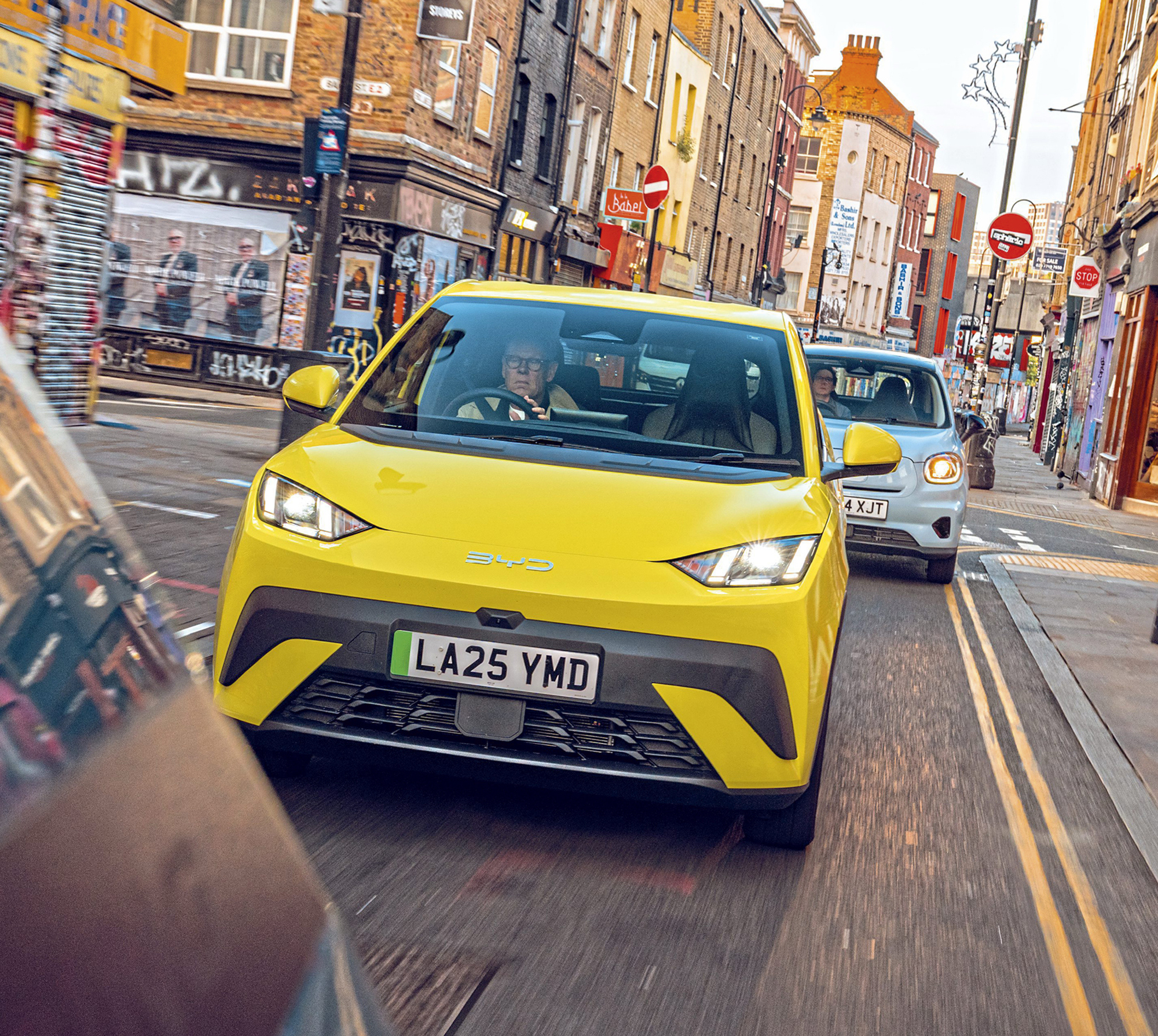
It feels entirely different from the smaller and cruder Dacia and Leapmotor. As much small B-class hatch as big city car, it’s 300mm or so – about a foot – longer than either and 400kg heavier than the featherweight Spring.
It has a much posher and more substantial cabin, in contrast to the cheery cheapness of the Dacia and the blandness of the Leapmotor. Material quality is very good, including handsome faux leather trim and shapely (and comfortable) front seats. It’s considerably roomier in the rear too: two tallish backbenchers could even enjoy a long journey. The boot is big and practical, although no bigger or more usable than the Spring’s.
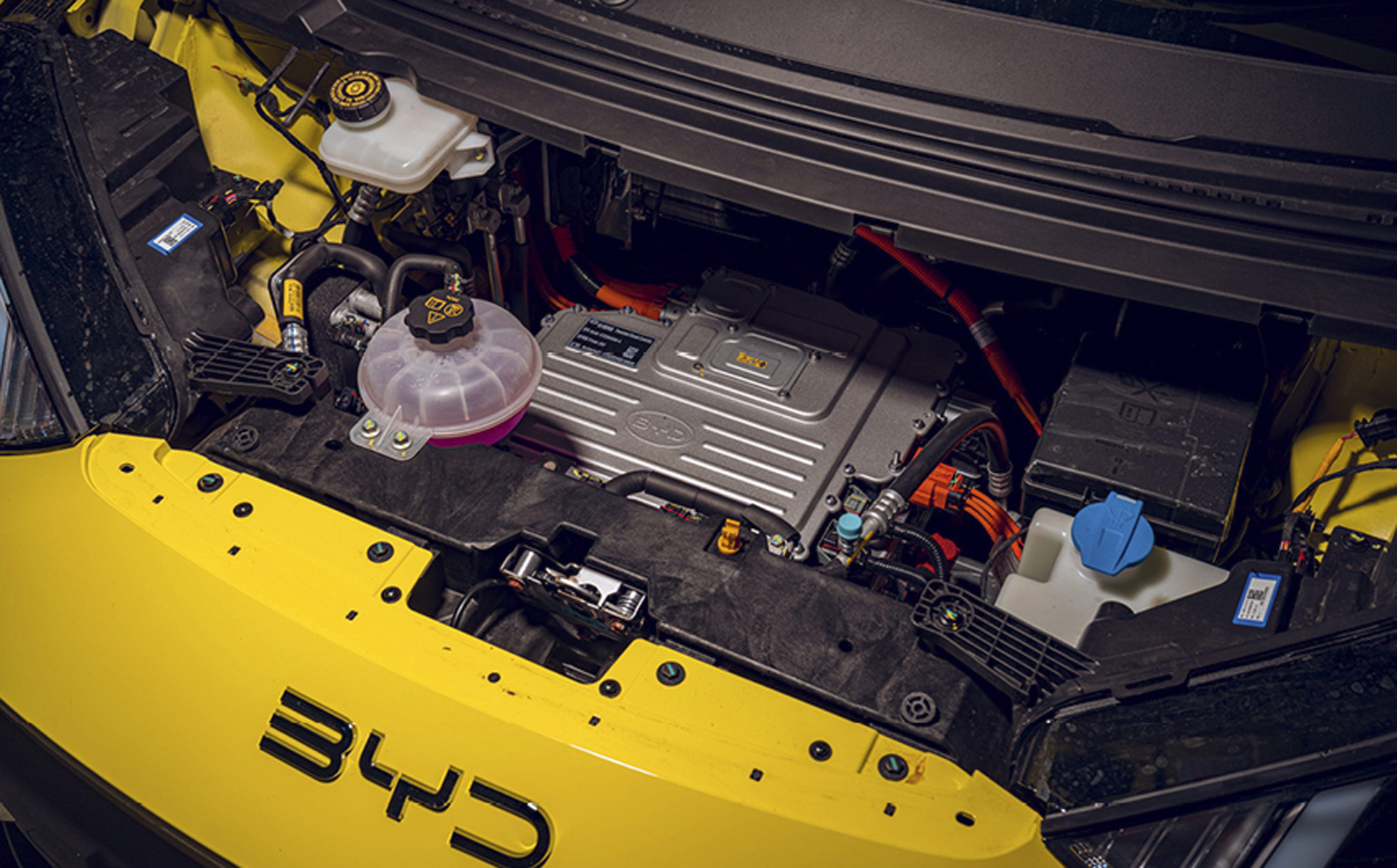
The rotating infotainment screen – vertical or horizontal – has more info than the rivals here, and sharper graphics. There are numerous sub-menus and myriad settings. The technophiles will mostly love it while analogue-anchored EV newbies may prefer the simplicity of the straightforward Dacia, a car you just get into and go, rather than get in and scroll through touchscreen menus.
As in the Leapmotor, there are too many bings and bongs to distract and annoy, all in the name of safety. There’s also an annoying voice assistant to harangue you. I just hate all this stuff.

Bigger, roomier BYD the nicest cockpit
Outside we find a wedgy, fussily styled little thing, lacking the simplicity and grace of the Spring. Its body height also makes it looked under-tyred, never mind that our test car rides on 16-inch alloys, wearing a decent set of biggish Korean Hankook tyres.
In its intended milieu – town – its compactness makes it easy to position and park, and the ride is pretty good. Not as pothole absorbent as the spongy-springed Spring, but quite okay, and considerably more capable than the Dacia when speeds build. The powertrain is smooth, the brakes a little mushy, steering the best of our trio: fluid and with decent weighting.
On the motorway, it’s the best of the bunch and by some margin. It’s the only small city EV at this price that could venture from London to Birmingham (almost) as happily as from Lewisham to Brixton. That’s partly because its performance is easily the best here. Remember, our test car is the top-spec Comfort, complete with 154bhp as opposed to the Dacia’s 64. Yet even the entry-level Active – at £18,650, just £1000 more than our test Spring – has 87bhp and can sprint 0-62mph from rest 11.1 sec. That’s notably quicker than the Dacia or Leapmotor.
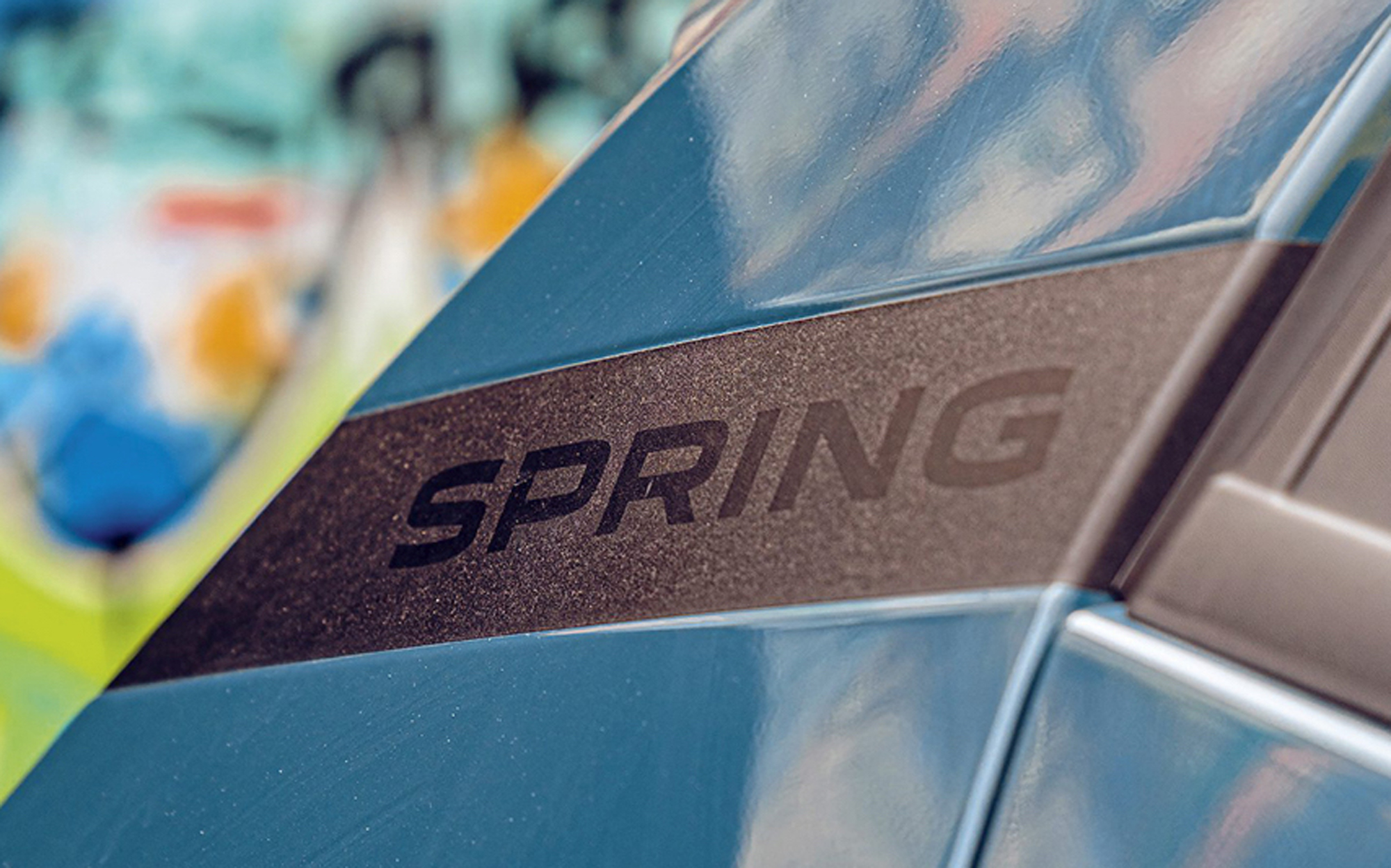
Fun, bright, breezy – the name fits
The entry-level Surf is also well equipped, including intelligent high beam, heated side mirrors, faux leather steering wheel and seats, 50:50 folding rear seats (where the rivals both have one-piece seats), Apple CarPlay and Android Auto, rear camera, adaptive cruise control and V2L for powering appliances.
It’s best for EV techies too, boasting clever features including what BYD calls its ‘8-in-1’ powertrain (smart packaging of the e-motor, transmission, vehicle control unit, battery management system and so on). It’s more space efficient and, says BYD, more energy efficient.
The innovative Blade battery, made by BYD, is part of the car’s structure and uses lithium iron phosphate that’s free from controversial cobalt, as sometimes mined by poor Congolese kids. BYD also says this new battery is more heat resistant and safer, too.
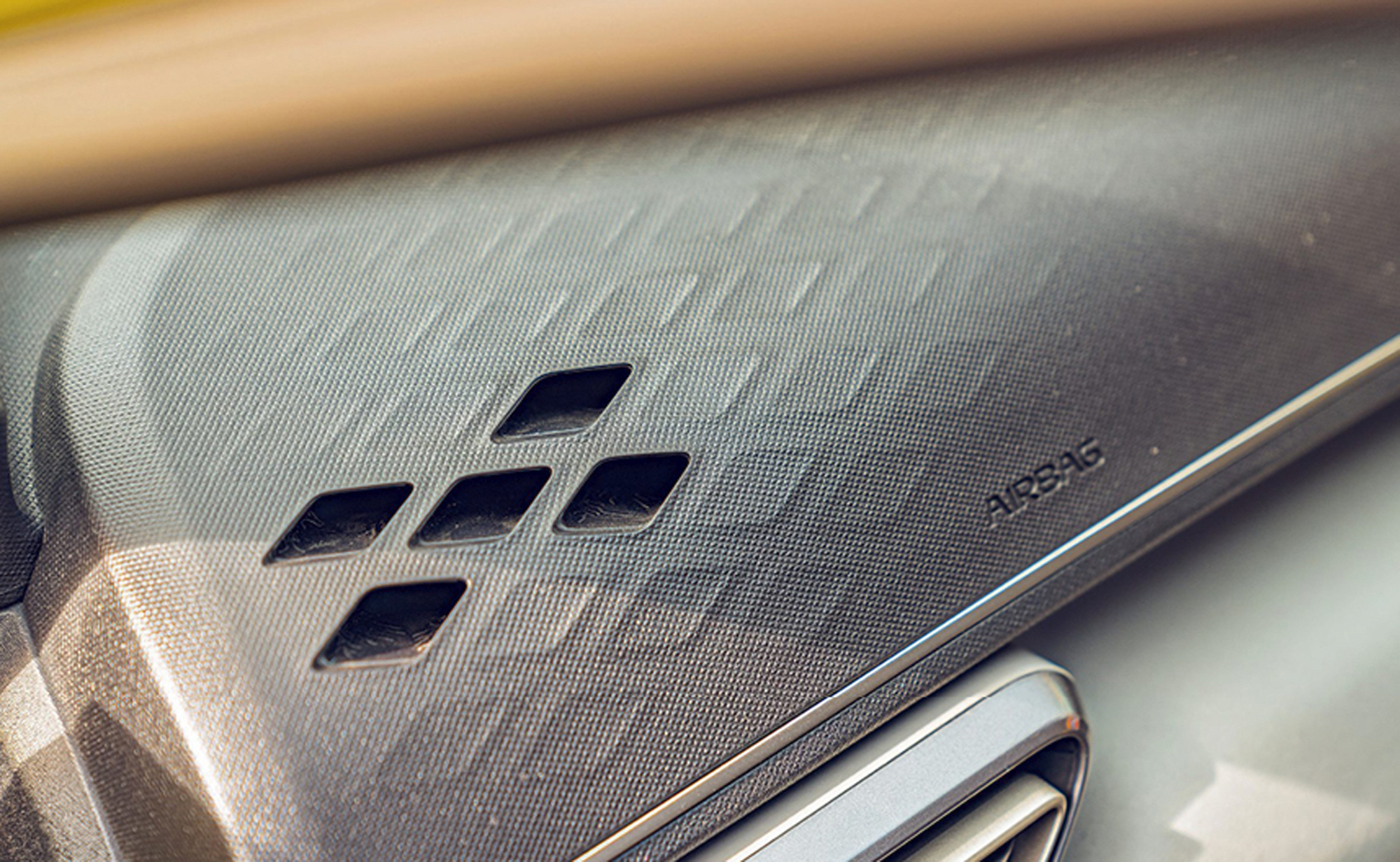
The base Surf gives an official range of 137 miles, about the same as the Dacia, but behind the Leapmotor’s 165. Our top-spec Comfort boosts that to 193.
It has a much faster charging speed, too. On the other hand, city EVs will mostly be charged at home, not on journeys at public chargers, so charging speed is less of an issue.
So, the good news is that there are finally some players in the small cheap EV market. More are on the way, including contenders from Volkswagen, Nissan and Honda, as well as new Chinese offerings such as the Nio Firefly.
None, so far, is a breakthrough car in this sector; they don’t change the game in the way the fine Renault 5 does in the class above. That car proves what’s possible when the stars align, and design, tech and price all come together perfectly. In the meantime, we have three reasonable little EV tots of varying capability and character, all vying to win this test.
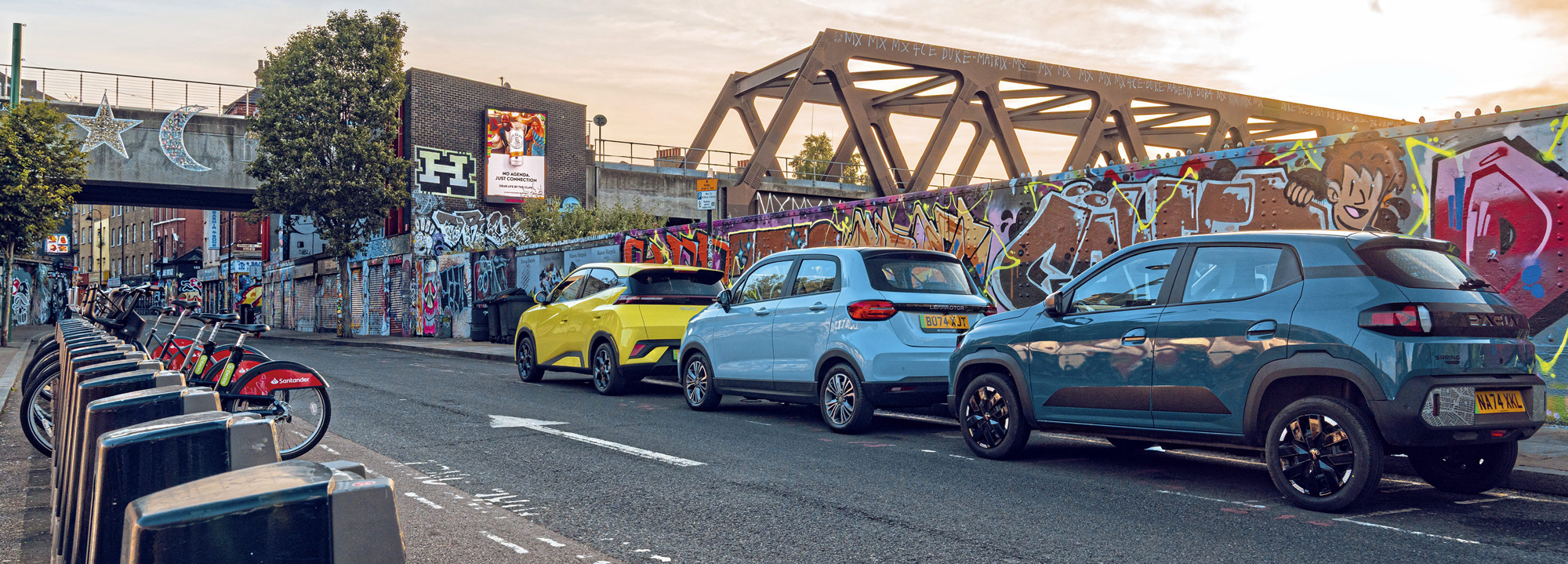
Nothing’s easy to park in London. But these are easier than most
The Final Reckoning
SMALL. PERFECTLY FORMED?
There is a case to be made for each of our protagonists. The Dacia is the most polarising. Its chief virtues – apart from that bargain basement price – are that it can be fun to drive, and it has character. But as we know, one person’s charming is another’s compromised. It is mechanically the crudest, feels the flimsiest, and has the smallest bandwidth of capability. It’s far from a clean-sheet new car, and I’m quite sure Renault and Dacia could make a better small city car if starting from scratch.
On the other hand, I like its roly-poly demeanour and the soft and absorbent low-speed urban ride. It reminds me of old French cars, including the Renault 4 of fond memory. Such comparisons gain legitimacy when you note that Dacia is, of course, part of Renault, and there is French influence in the Spring.
I also like its EV contrariness. It’s light and small, while most are big and fat; it’s easy to use when most are complicated. Its style is simple and appealing. Its lightness also gives excellent efficiency, the best here.
The Leapmotor, as tested, is the cheapest car here. It offers more per pound sterling than any rival, which is arguably the whole point of these cars. By some margin, it’s the car that most exceeded my expectations. If you want a capable and cheap little urban runabout, it does the job well.
On the other hand, there is little panache, zero design flair, and nothing to love. Its dim-witted steering also means it lacks agility, unforgivable for a small car. Perhaps more important to many, its infotainment system also needs a total rethink.
If we look at all this with ruthless objectivity, the best car is the BYD. It’s the most capable, most versatile, the most modern, the best to drive, the most spacious and has the most tech. It feels a cut above its rivals here. Objectively, it must win.
But it’s not a great small car. Small cars should be nippy and agile, fun and functional, clever and characterful; brilliantly packaged with design panache. Smallness should mean extra engineering creativity, as evinced by great small cars of the past. There should be a nobility of purpose rather than merely a marketing need. Smallness should be a virtue, not just an economy. car
1st
BYD DOLPHIN SURF
Highly capable, with lots of kit and good value. Good in town and beyond
2nd
DACIA SPRING
Fun to drive and be around, and it’s charming. But lacks the outright capability of some rival EVs
3rd
LEAPMOTOR T03
Competent and very cheap. Little cars should be more characterful, though
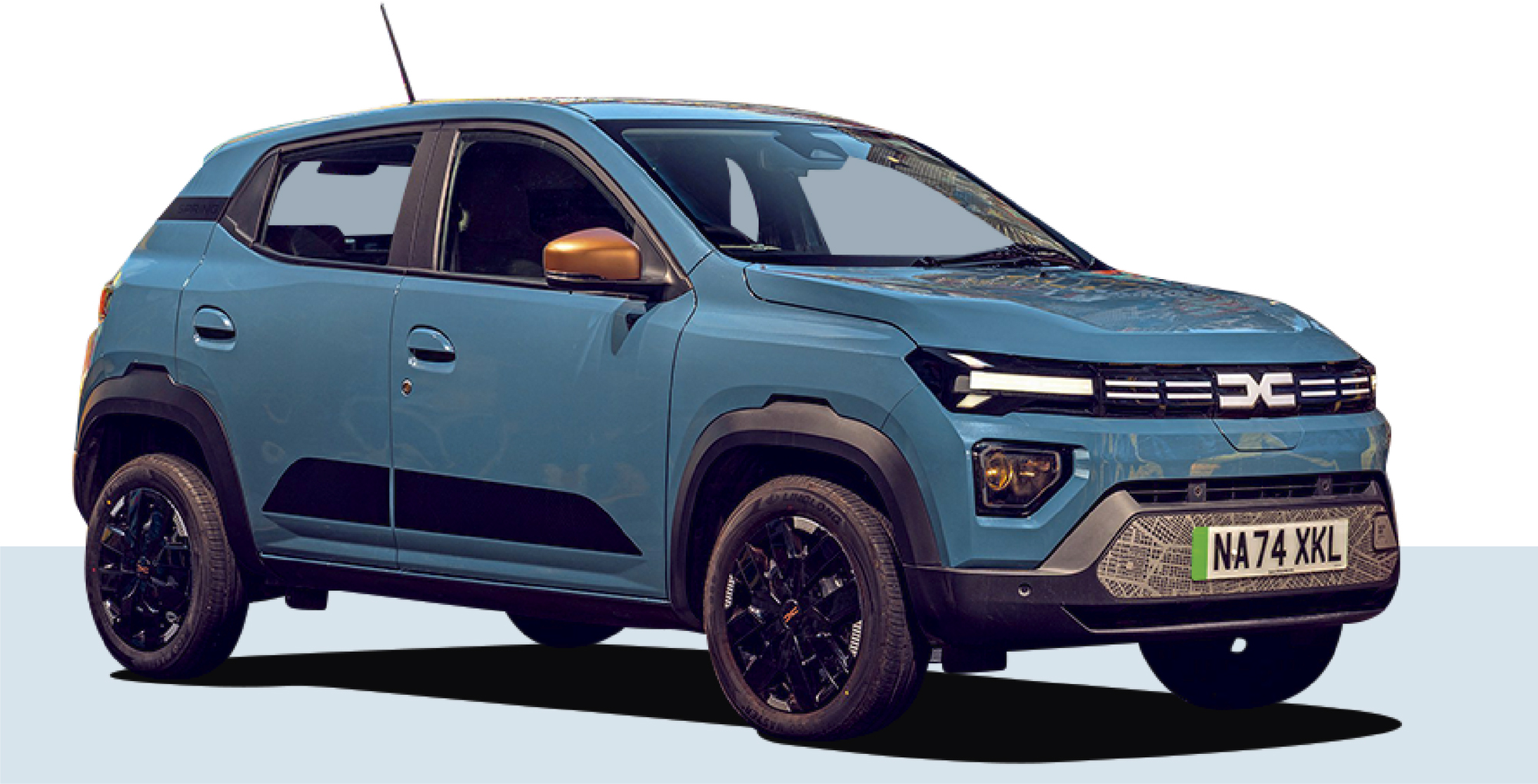
Facts & Figures | DACIA SPRING
What’s the line-up?
The cheapest EV sold in the UK is the Spring Expression, yours for just £15k. You get a 44bhp motor and 140-mile range. The upgrade to the Extreme gets you 64bhp. The price balloons to £16,995, but it’s surely worth it.
Data
Price £14,995 (£17,645 as tested)
Powertrain 26.8kWh battery, e-motor, front-wheel drive
Performance 64bhp, 83lb ft, 13.7sec 0-62mph, 78mph
Weight 984kg
Efficiency 5.2 miles per kWh (official), 5.0 miles per kWh (tested), 140-mile range (official), 134-mile range (tested), 0 g/km CO2
Length/width/height 3701/1583/1485mm
Boot capacity 308 litres
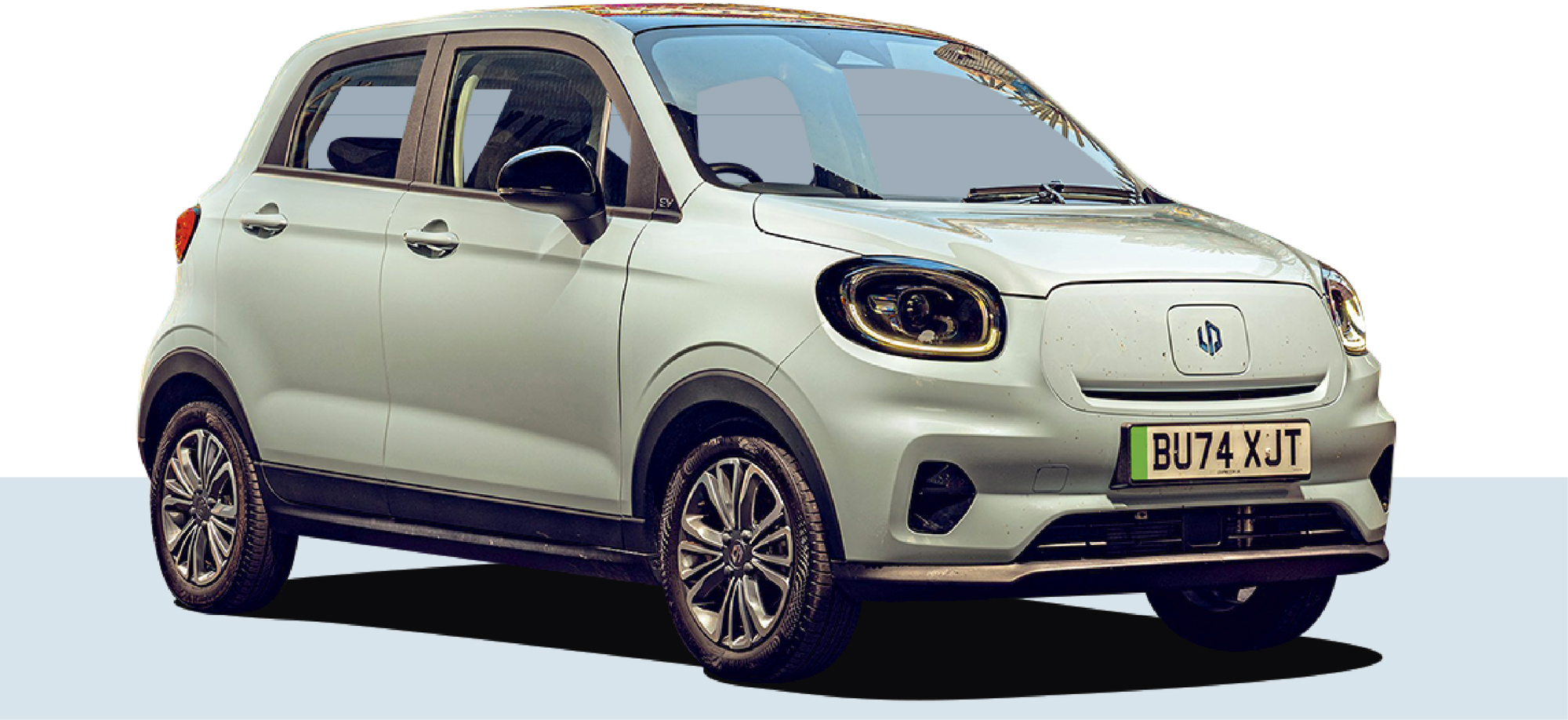
Facts & Figures | LEAPMOTOR T03
What’s the line-up?
Appealingly, there is a line-up of one. No options bar fancy paint, no variants. Your £15,995 gets you adaptive cruise control, a rear-view camera, a sunroof with power blind, alloys, over-the-air updates, voice control and remote vehicle control.
Data
Price £15,995 (£16,645 as tested)
Powertrain 37kWh battery, e-motor, front-wheel drive
Performance 94bhp, 117lb ft, 12.7sec 0-62mph, 81mph
Weight 1175kg
Efficiency 4.5 miles per kWh (official), 4.2 miles per kWh (tested), 165-mile range (official), 155-mile range (tested), 0g/km CO2
Length/width/height 3620/1652/1577mm
Boot capacity 210 litres
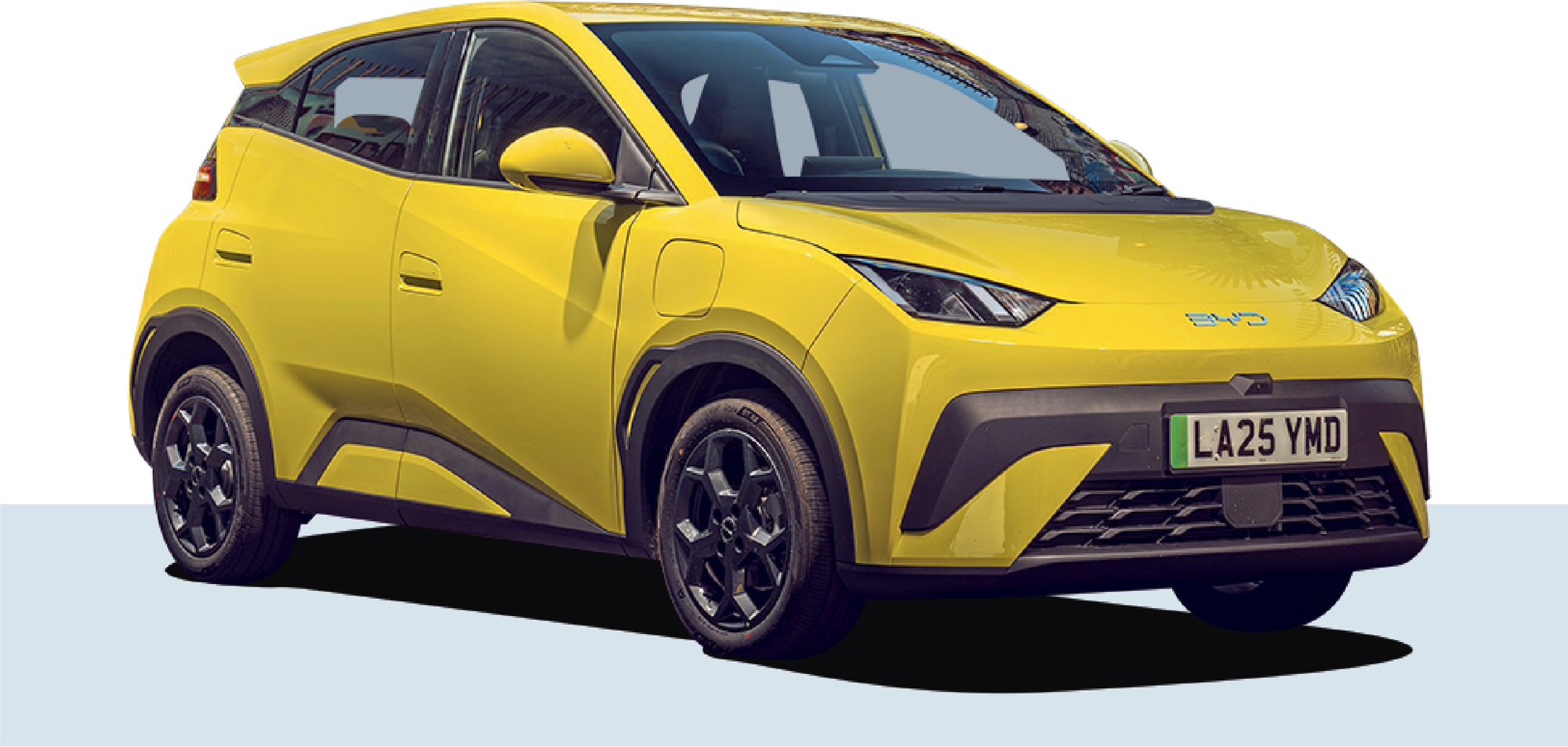
Facts & Figures | BYD DOLPHIN SURF
What’s the line-up?
Choices start with the Active at £18,650, with a 30kWh battery and 137 miles of range. The Boost version (£21,950) gets the bigger (43.2 kWh) battery and better range. The top-spec Comfort, as tested here, is very well equipped.
Data
Price £18,650 (£23,950 as tested)
Powertrain 43.2kWh battery, e-motor, front-wheel drive
Performance 154bhp, 162lb ft, 9.1sec 0-62mph, 93mph
Weight 1390kg
Efficiency 3.88 miles per kWh (official), 3.9 miles per kWh (tested), 193-mile range (official), 168-mile range (tested), 0g/km CO2
Length/width/height 3990/1720/1590mm
Boot capacity 308 litres

